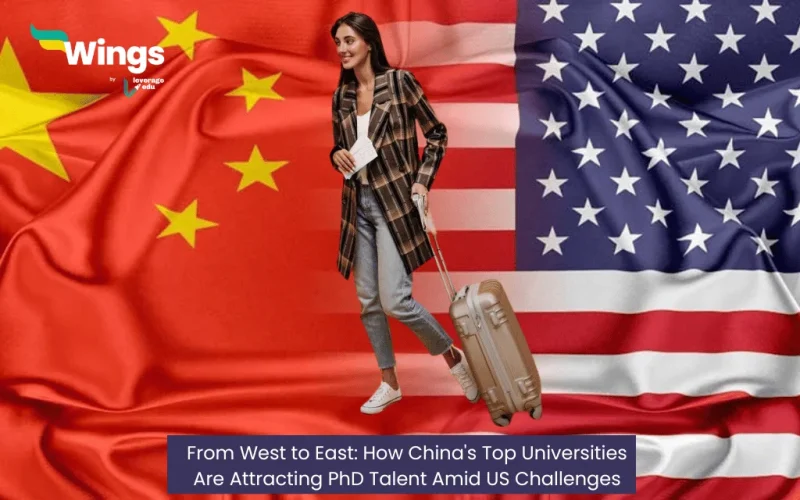In recent years, a significant shift has been observed in global academic trends. As the United States faces funding cuts and suspends graduate admissions, China’s leading universities are seizing the opportunity to attract young scholars, especially those of Chinese descent studying abroad. This movement not only reflects China’s ambition to become a global research hub but also offers promising avenues for students seeking advanced academic pursuits.
This Blog Includes:
China’s Strategic Recruitment Initiatives
Fudan University, a prestigious institution in Shanghai, has been at the forefront of this recruitment drive. Since 2022, Fudan has been offering direct PhD admissions to overseas Chinese undergraduates, bypassing the traditional requirement of a master’s degree or endorsements from domestic universities. This initiative targets students from the world’s top 100 universities, encompassing disciplines like computer science, biomedical engineering, clinical medicine, and select humanities subjects. Such a move is relatively uncommon in China, where doctoral admissions typically necessitate a master’s degree or recommendations from local institutions. A faculty member from Fudan emphasized that this approach aligns with the university’s commitment to social responsibility and academic excellence.
US Academic Landscape: Challenges and Implications
The United States has long been a magnet for international scholars, offering unparalleled research opportunities and resources. However, recent developments have introduced challenges that are reshaping this landscape.
- Funding Reductions: Many American universities are experiencing financial constraints, leading to cuts in graduate program funding. This has resulted in the suspension of admissions for certain disciplines, leaving prospective students in a state of uncertainty.
- Geopolitical Tensions: The strained political relationship between the US and China has led to increased scrutiny of Chinese scholars. Policies such as the China Initiative have instilled apprehension among Chinese researchers, prompting some to reconsider their academic futures in the US.
- Visa and Immigration Hurdles: Stricter visa regulations and prolonged processing times have made it challenging for international students to commence or continue their studies in the US. This bureaucratic red tape adds another layer of complexity for those pursuing advanced degrees.
China’s Response: Creating Attractive Academic Opportunities
In light of these challenges, China has proactively positioned itself as an appealing alternative for scholars. The nation’s strategy encompasses several key elements:
- Generous Funding and Resources: Chinese universities are offering substantial financial support to attract top-tier talent. For instance, programs like the Thousand Talents Plan provide competitive salaries, significant research funding, and additional perks such as housing subsidies and guaranteed employment for spouses. These incentives are designed to create a conducive environment for research and innovation.
- Streamlined Admission Processes: By allowing direct entry into PhD programs for outstanding undergraduates from esteemed global institutions, China is removing traditional barriers and expediting the academic progression for these students. This approach not only accelerates their research careers but also integrates them into China’s academic fabric more swiftly.
- Enhanced Research Infrastructure: Significant investments have been made to bolster research facilities and resources across Chinese universities. This commitment ensures that returning scholars have access to state-of-the-art equipment and support, enabling them to conduct cutting-edge research.
The Broader Implications for Global Academia
This shift in academic trajectories carries significant implications for the global research community:
- Diversification of Research Hubs: As China attracts more international talent, it is emerging as a formidable center for research and innovation. This diversification challenges the traditional dominance of Western institutions and fosters a more multipolar academic world.
- Collaborative Opportunities: The infusion of diverse perspectives and expertise into Chinese universities enhances the potential for groundbreaking research. Collaborations between returning scholars and local researchers can lead to innovative solutions to global challenges.
- Policy Reforms in Western Institutions: The migration of talent towards China may prompt Western universities and governments to re-evaluate their policies. To retain and attract top scholars, there may be a renewed focus on providing adequate funding, ensuring job security, and fostering an inclusive environment for international researchers.
The Evolving Academic Landscape
The dynamic interplay of geopolitical factors, funding realities, and institutional policies is reshaping the pathways of emerging scholars. China’s proactive measures to welcome and support these individuals not only bolster its own academic standing but also contribute to a more interconnected and collaborative global research environment. For students contemplating their academic futures, staying informed about these developments and remaining adaptable is crucial in navigating this evolving landscape.
FAQs
Due to funding cuts and increased scrutiny in the US, many Chinese undergraduates are exploring opportunities in China, where universities offer generous funding, streamlined admissions, and robust research support.
Chinese institutions provide substantial financial incentives, including competitive salaries and research funding. They also offer modern research facilities and a supportive environment for innovative projects.
Rising geopolitical tensions have led to stricter visa regulations and increased scrutiny of Chinese scholars in the US, prompting many to seek more stable and welcoming environments in China.
Yes, China’s academic growth is fostering a more interconnected research landscape. Increased collaboration between international scholars and Chinese institutions is expected to drive innovation across multiple disciplines.
For more insights on exploring new updates in international education trends, visit Leverage Edu News Updates.
 One app for all your study abroad needs
One app for all your study abroad needs















 60,000+ students trusted us with their dreams. Take the first step today!
60,000+ students trusted us with their dreams. Take the first step today!